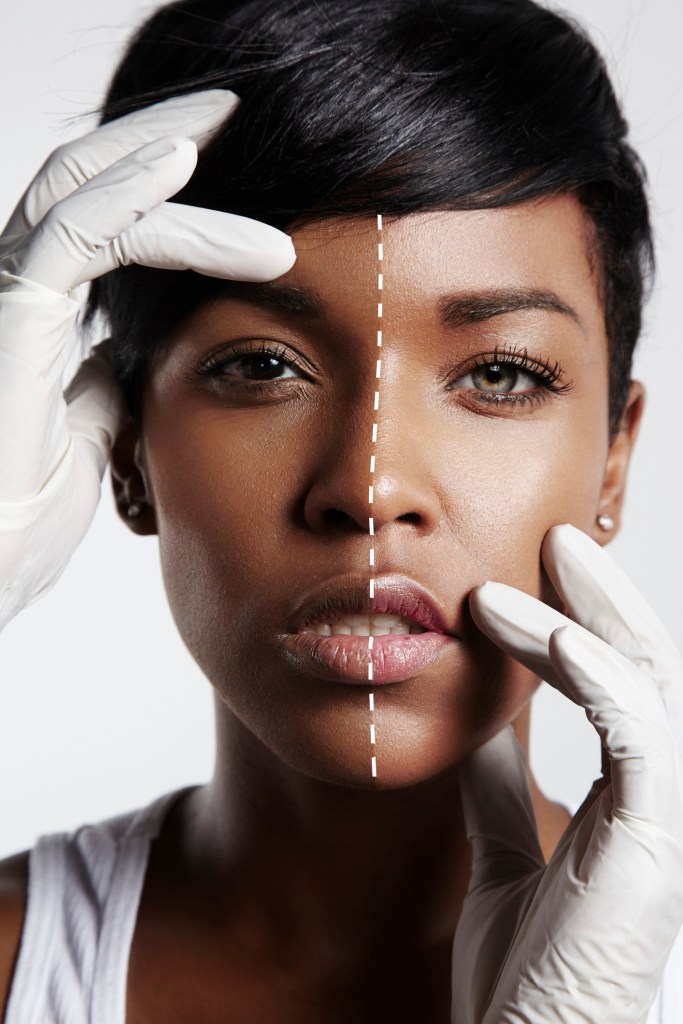A pale kid growing up in foggy Nova Scotia, Canada, Trevor Ritchie started using tanning beds at age 15. He would visit the tanning salon once a week until his senior year of high school, when he says “the tanning really took off.” For the next five years, he tanned twice a day at two different tanning salons—his strategy to circumvent most salons’ one-session-per-day maximum. “I was the color of a tree branch,” he says.
One day he spotted a mole on his arm, which turned out to be a type of skin cancer called basal cell carcinoma. He blames his tanning bed use, since he has no family history of skin cancer. Yet after his dermatologist removed the mole and declared him cancer-free, back to the tanning salon he went—about four times a week for five more years. “I would feel extreme anxiety getting into the tanning bed,” says Ritchie, now 30 and sun-free for the past two years. “I would hate myself.” But he couldn’t help it.
Videos by VICE
Meanwhile, 29-year-old Nicole Manlangit of Manila, Philippines craves the opposite: “creamy white skin.” Manlangit, who reviews skin lightening products on her YouTube Channel, began lightening her skin about six years ago. Every morning and night, she lathers herself with lightening soap and smooths on lightening lotion, readily available at drugstores throughout the Philippines. Sometimes, she applies bleaching cream and occasionally takes skin lightening pills. She views comments that she looks too pale as compliments. In fact, she wishes she were even more fair-skinned, like the actors in the Korean dramas that have exploded in popularity in the Philippines. “It’s impossible, but that’s what I want,” she says.
You needn’t look too far to find examples of others who have gone to great lengths to lighten or darken their skin. Instagram selfies revealing a lily white Lil’ Kim made headlines in 2016; a few years earlier, Patricia “Tan Mom” Krentcil, arrested for taking her five-year-old daughter into a tanning bed, had gained notoriety for her dark brown hue.
What motivates someone to drastically alter their skin tone? Mental health experts say that sociocultural perceptions of attractiveness—and therefore, power—play a major role. “There are real social benefits from having darker or lighter skin,” says Becky Choma, director of the social and political psychology lab at Ryerson University in Toronto. In more extreme cases, psychiatric issues like body dysmorphic disorder (BDD) or addiction, may also be to blame, leading to uncontrollable urges to tan or lighten skin.
More from Tonic:
With melanated folks often striving for lighter skin and vice-versa, it’s easy to blame efforts to alter our skin tone on a natural human tendency to want what we don’t have. Choma believes the reasons might be more complicated. “I think the general psychological process is the same [for bleaching and tanning],” she says. “Women internalize this notion that we should be beautiful.” But beauty standards also stem from cultural norms. Kelly Lewis-Arthur, a clinical community psychologist in Atlanta, Georgia, agrees. “There are culturally specific notions of beauty,” she says. “It’s important to acknowledge that.”
These notions of beauty often reflect notions of power, which also differs across cultures. In other words, “powerful” may look different in white communities than it does in communities of color. After the Industrial Revolution, tanning became “an index of wealth” in Europe, Choma says, conveying the message: “I have the money. I can take time off and go outside.” Indeed, Ritchie began tanning in the early aughts, inspired by Paris Hilton and The Simple Life. “Tanning at the time was representative of a more luxurious life,” he says. He relished the times when his tan prompted his friends to ask where he had gone on vacation.
In many communities of color, on the other hand, there’s often historically been “a hierarchy along the lines of skin color, where you have light at the top of the chain and dark at the bottom,” Lewis-Arthur says. Manlangit’s Philippines is no exception. After centuries of colonial rule under Spain and the US, “Filipinos…look up to white people as wealthier. Being white [is] a status symbol,” she says. “They think having whiter skin is much more beautiful,” Filipino entertainment is awash with half-white celebrities, further perpetuating this mentality (this is the case for many countries across Asia and Africa). Having white skin also suggests an ability to afford skin lightening products.
But it’s important to note that “this is all happening within a society that privileges lighter skin over darker skin,” Choma says. While both tanning and bleaching can be, for some, a way to gain social status, “implications for status are more strongly tied to skin tone for bodies of color.” In India, where Choma has studied skin bleaching, fairer-skinned women reap more social benefits than darker-skinned women, such as higher-paying jobs and being considered more attractive by upper-class men. Yet “whether a white person tans does not have the same sort of relation to whether they get a particular job, make more money or achieve a particular social standing,”
But what about more extreme cases? What motivates people to keep lightening or darkening their skin, despite suffering health consequences, and even if most of us would find the results less-than-flattering, if not altogether shocking? While sociocultural factors may still underlie these cases, Choma says, such extreme behavior suggests there might be more at play, like the difference between disordered eating–regularly engaging in abnormal eating behaviors, such as scrupulous calorie-counting—versus a full-fledged eating disorder.
BDD may be the culprit in some cases. For the roughly 1 in 50 people worldwide who have the disorder, there’s a huge discrepancy between what they see in the mirror and what others see. People with BDD aren’t just dissatisfied with their looks: “They obsess about perceived physical defects,” says Katharine Phillips, a professor of psychiatry at Weill Cornell Medicine and an attending psychiatrist at New York-Presbyterian Hospital, who has written multiple books on BDD. “Their brains are probably seeing things differently…The tiny details override the big picture.” Their obsession with the perceived defect causes them considerable emotional distress and impairs their everyday functioning. It also spurs them to engage in repetitive, compulsive behaviors, or rituals, which can include bleaching or tanning their skin. These rituals, in turn, further fuel their obsession with the supposed flaw by keeping them fixated on it.
Phillips, who has researched tanning related to BDD, says most of her BDD patients tan because they see themselves as too pale. Others want to conceal acne, cellulite, or body hair. One patient thought tanning made her look more petite, while another believed that tanning the top of his head hid his baldness.
BDD rituals are usually extremely hard to resist for those engaged, Phillips says. Although we can’t say whether he had BDD, tanning might have been a compulsive ritual for Ritchie, drawing him back to tanning beds again and again, despite his cancer scare and the anxiety he felt each time. Even if tanning can make some people with BDD anxious, they “may want to do it just in case next time is different,” Phillips says. In other cases, tanning may temporarily alleviate their anxiety, which can also keep them coming back for more.
Erin Bonar, an assistant professor of psychiatry at the University of Michigan Medical School, and Lisham Ashrafioun of the VA VISN 2 Center for Excellence for Suicide Prevention at Canandaigua VA Medical Center wanted to understand what features of excessive tanning might be similar to substance addiction. Since a key component of addiction is craving—the urge or desire to use the substance—they modified an assessment designed to measure alcohol cravings to instead measure cravings to tan. The young adults in the study who scored high on cravings to tan tended to tan more often and spend more money in a typical month on tanning.
These cravings to tan are “very similar to what you might see in someone who uses substances despite having lots of problems associated with them,” Bonar says. Ritchie, who actually refers to his tanning as an “addiction,” compares the tanning sessions after his cancer scare to someone dashing outside for a cigarette break. “I knew it was wrong, and therein lies the addiction,” he says.
Like those struggling with substance use disorder, excessive tanners seem to build a tolerance to tanning, meaning they need to tan more to yield a desired effect. Although now appalled by how tan he looks in old photos, Ritchie had a much different opinion at the time. “I thought I didn’t look tan enough,” he says. “It’s a tan you keep chasing that you can never really achieve.” Bonar says that sounds a lot like someone developing tolerance. “It’s like chasing a certain high.”
But Phillips remains wary of the term “tanning addiction.” She emphasizes the need for more studies to confirm that tanning causes the same biological changes as drug addiction does.
Two years ago, when he saw how flawless his best friend’s skin looked when she went sun-free, Ritchie decided to follow suit. He struggled whenever he passed the tanning salon on his way to the gym. “It took everything in me not to stop there,” he says. But he resisted and continues to stay out of the sun, walking in the shade, and wearing long sleeves and pants. “I just had to prioritize my health before beauty standards.”
Like tanning, skin bleaching also carries health risks. Lightening creams can cause itching and flaking. Those containing hydroquinone, mercury or corticosteroids can trigger more serious side effects, like thinning of the skin and even kidney damage. Manlangit says some skin lightening pills have made her “want to vomit.” Yet why do some people use these products regardless?
Choma speculates that “it likely relates to the degree to which they are looking at themselves as an object rather than as a whole person.” Most women can relate to that, at some level—squeezing ourselves into stilettos and gritting our teeth through Brazilian waxes, all in an effort to meet unrealistic beauty standards. In her research on skin bleaching in Tanzania, Lewis-Arthur also found that many women falsely believed that if they just continued to use their lightening products, the acne, skin discoloration and other side effects they caused would disappear.
But even for people who go to extreme lengths to change their skin tone, Arthur-Lewis believes “you have to look at the cultural context.” While it might be easy to write them off as mentally ill, she says the issues run deeper than mental health—especially among those who lighten their skin. “On the surface, they’ve got psychological issues they need to deal with, but they also have to deal with survival,” she says. “To really understand why people do what they do, you have to look at the historical context, the background of the people and the community they’re living in.”
Sign up for our newsletter to get the best of Tonic delivered to your inbox.




